As microscopy techniques become more complex and require researchers to keep specimens under objectives for longer periods, microenvironmental control systems play an important role in pushing the limits of live-cell imaging.
DANIEL FOCHT, BIOPTECHS INC.
Choosing a microenvironmental control system for a microscope is not a trivial matter. The results of a live-cell imaging experiment should not be compromised by any part of the data acquisition process. Typically, live-cell experiments can be classified into two categories: developmental studies to establish natural behavior and induced change to study the effects of a controlled factor. Either way, advanced microenvironmental control systems are increasingly playing an important role in breakthroughs in cell biology, in vitro fertilization, tissue engineering, oncology research, neurology and other applications.
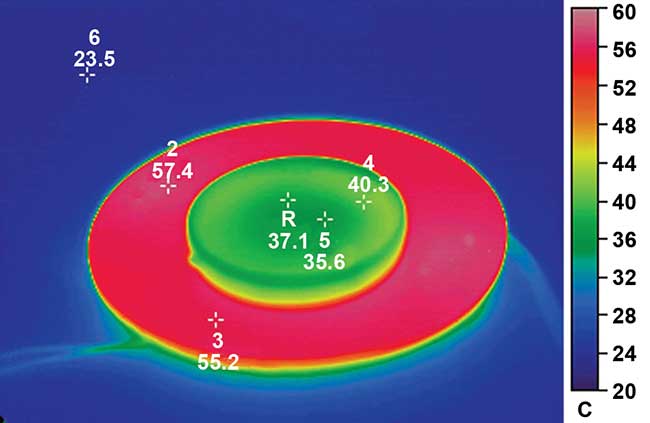
Open culture dish resting on a traditional heating stage insert. Note, even after an hour of equilibration, there is a huge temperature gradient. Courtesy of Bioptechs Inc.
Microscope design
Microscopes are primarily designed for and around fixed slides. Consequently, live specimens need to be contained in an apparatus that is both compatible with the microscope optics and conducive to the physiological requirements of the specimen. In the early days of live-cell imaging of mammalian specimens, researchers simply placed a warming plate on the microscope’s stage, which had a hole in it where the specimen was situated within the axis of the microscope. This approach is still used today in select, low-magnification applications. However, this technique suffers from critical shortcomings.
One of these shortcomings is that heat is produced peripherally and propagates to the specimen area by a combination of radiation and some direct thermal conductivity. The amount of the latter depends on the degree to which the specimen containment structure comes in direct contact with the heated plate, resulting in long equilibration times and a temperature gradient across the field.
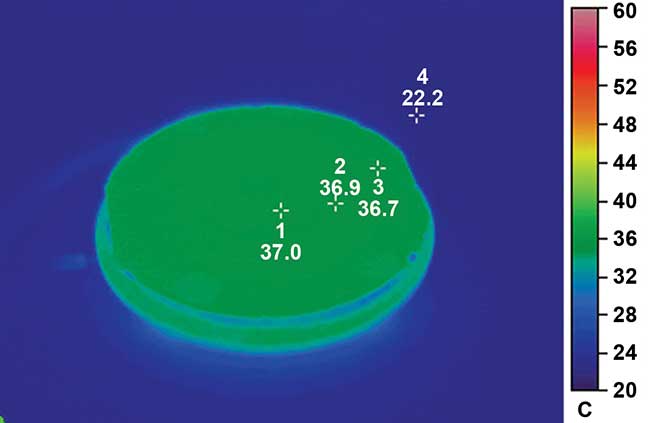
Thermographic image of the bottom of a Focht Chamber System 2 indicating the uniformity of temperature distribution. Note the coverslip temperature is the same as the surrounding supportive structure, a feature not possible when heat is only applied peripherally. Courtesy of Bioptechs Inc.
Due to the expansion of the heating plate and the microscope stage in contact with it, the specimen does not adequately remain in focus for time-lapse studies using high-magnification lenses. These adverse effects should make researchers think twice before using what is traditionally known as heating or warming stages.
Stage-top incubators
For many mammalian live-cell experiments there is also a need to control gas and humidity, prompting the development of stage-top incubators. This equipment provides a warm, sometimes humidified small stage-top enclosure, where the temperature, air and/or gas environment is controlled by an external apparatus. Stage-top incubators are a step up from a warming plate and are most commonly used for and with multiwell Society for Laboratory Automation and Screening (SLAS) plates as well as a variety of standard labware.
Stage-top incubators are often used for applications where low magnification, low numerical aperture (NA) objectives are used. Heat is applied both peripherally and sometimes in combination with intrinsically heated glass plates that the specimen containment structure rests on. This method offers the option of a heated glass lid to permit transmitted light microscopy. Although stage-top incubators do work, and have become popular, they suffer from the following drawbacks:
• They tend to induce Z-axis drift due to thermal expansion of both the enclosure itself and the stage of the microscope that is in contact with it.
• They also usually have a glass plate in the bottom between the specimen containment structure and the objective. The glass plate introduces additional optical surfaces and space between the specimen and the objective, prohibiting the use of high magnification and high NA lenses.
• They often require bulky support hardware for the regulation of temperature and gas flow.
Enclosed microscopes
A third evolution in microenvironmental control is to enclose the entire microscope in a temperature-, gas- and humidity-controlled enclosure. This technique provides improved Z-axis stability to the scope and physiologically supports the specimen. It is expensive and operates well but is also cumbersome to work in, requiring long equilibration times and excessive amounts of carbon dioxide (CO2). Additionally, if a flow cell for induced change experiments is needed, it must be purchased separately. Blowing warm humidified air into an expensive microscope gives pause to many researchers.
Microenvironmental control systems advancements
As microscopy has evolved with methods such as confocal, multiphoton, stimulated emission depletion (STED), serial plane deconvolution and superresolution, the demands on the environmental control systems have increased. In response to the more demanding requirements and needs for imaging longer periods of time, more advanced and sophisticated microenvironmental control systems have been developed.
To properly identify the type of system and components that are optimal for any particular project, it is necessary to make a comprehensive evaluation of the whole project. This includes the requirements of the intended protocol; type of specimen; its containment structure; its physiological needs such as gas, media perfusion and temperature; and whether there are any changes or variant factors that need to be introduced. In addition, there are numerous microscope factors, such as the modes and/or combinations of modes of microscopy, the characteristics of the optics used, and the geometry of the microscope.
For example, the closest components to the specimen are the objectives and condenser. Consequently, the magnification and working distance of these components, as well as their optical coupling, pose specific limitations on the configuration of the environmental system. Other factors include the upright or inverted orientation of the observation path, the geometry of the stage and stage accessories such as Piezo control, and the use of micromanipulators, injectors or any other stage-mounted components. Finally, the time factors such as the length of time the specimen remains on the scope, along with the duration and interval of image acquisition, can also impose limitations.
Selection considerations
In selecting a microenvironmental strategy, researchers should weigh the physical characteristics of the specimen with the experimental protocol. This is where strategic choices have to be made. The main choice is whether to use a system where the specimen and the media within which they are contained is open in a structure, such as a dish. In such a structure the specimen and media are exposed to the atmosphere. Alternatively, researchers can choose a closed system where the specimen and media are completely sealed from the atmosphere in a flow cell.
Closed systems are always closed and sealed from the atmosphere, but open dish systems can be closed with the appropriate accessories. The main difference between a closed dish and a closed system flow cell is that a flow cell allows the user to precisely define the flow geometry of incoming media relative to the cells or tissue. A closed dish-based system can be accessorized with a cover to provide the ability to exchange media but there is no defined flow path. In other words, incoming media randomly mixes and diffuses throughout the dish.
Nearly any type of specimen can be maintained on the scope, including adherent cells, suspended cells, natural tissue or an artificial membrane. There are specific options for each of these categories. Adherent cells may be observed in static media or in flow. If static, a nonperfused dish is adequate. However, researchers then have to determine whether the cells and media should have contact with the natural atmosphere or if a controlled atmosphere is needed.
Natural atmosphere applications
For natural atmosphere applications, an open dish can be used. If a controlled gas environment is needed, the dish will need either a heated lid with humidified gas control or an atmospheric seal to prevent osmolarity shifts due to evaporation. If the introduction or exchange of media is necessary, there are accessories available to accommodate perfusion. If the specimens are suspended cells, they typically need to be closely contained within a small region either by a mechanical barrier, such as a culture cylinder, or suspended within a thixotropic media.
In the case where there is a need to measure the influences of shear forces, or to rapidly introduce variant factors, a flow cell is required. Cells, tissue or functionalized surfaces to be observed in flow are either plated on a coverslip or attached to an optical surface that is a component of the flow chamber. Advanced technologies for this purpose for use with inverted and upright scopes may include a user-definable optical cavity and uniform temperature distribution without the need of an external enclosure.
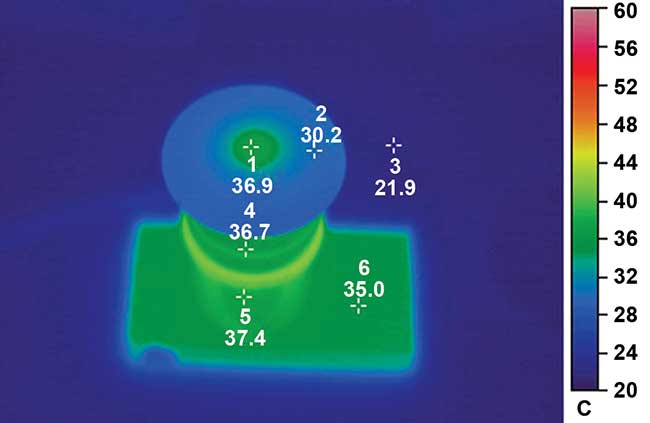
Coverslip resting on a 37 °C objective indicating the thermal ‘footprint’ and thermal influence of the temperature of the objective on the specimen. Courtesy of Bioptechs Inc.
Tissue observations
When the specimen is tissue, either natural or artificial, it can be easily observed with the appropriate accessory. The options are laying on a coverglass surface in a dish, suspended in a dish with media on an inverted scope, or resting on a nutrient exchange surface such as an artificial membrane while being imaged through a water dipping lens on an upright scope. To maximize the efficacy of any of these methods and ensure the specimen is properly positioned within the focal plane of the objective, users may elect to employ a dish system with a built-in temperature control coating on the bottom surface of the coverslip. Consequently, the heat is directly applied to the contents of the dish without heating the stage adapter that holds the dish. The result is an unheated stage and a warmed specimen. There is a wide range of accessories for this type of dish system to accommodate nearly all specimen types. Researchers just need to get the specimen into the dish where the optical, fluidic and thermal conditions are controlled.
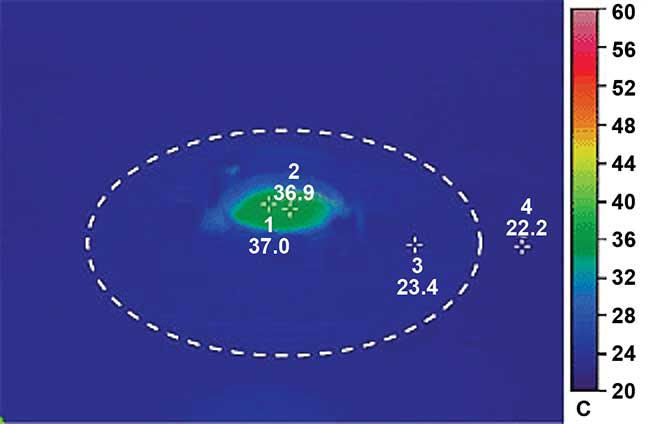
Thermal image of a Delta T Culture Dish indicating the efficient method of controlling the temperature of the specimen without warming the stage or inducing thermal expansion to the frame of the microscope. The dotted line represents the perimeter of the stage adapter resting in the stage; otherwise it would not be visible in an IR image. Courtesy of Bioptechs Inc.
Objective warming
For most live-cell experiments, especially long-term ones, a proper chamber or dish configuration, along with an objective warmer if high numeric aperture lenses are used, is sufficient. However, if the entire microscope is not in a temperature-controlled enclosure and high numeric aperture lenses are used, it is necessary to warm the objective.
Before investing in an objective warming system, researchers should recognize the physics behind it. An average objective weighs about 200 g and is made of glass, brass and airspace. It is screwed into a nosepiece that acts as a continual heat sink. It is essential that the objective heater has a high thermal conductivity to the objective so that excess heat does not radiate outward and convect upward toward the specimen. There are several types of objective warming products. The least effective is the Velcro-secured heating band. Another commonly used type is a metal heating collar. This type does a good job of regulating the heating ring but does not factor the temperature at the specimen plane, which is the real reason objectives are heated in the first place.
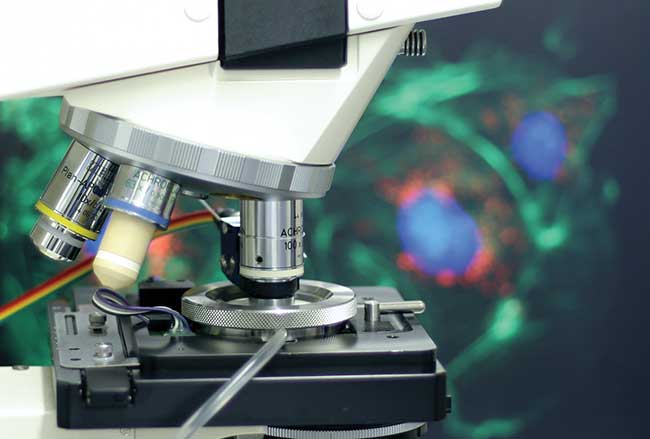
Focht Chamber System 3 (FCS3) and Objective Heater on an upright microscope providing a user-definable, laminar flow optical cavity, #1.5 coverslip and uniform temperature control without additional environmental support. Courtesy of Bioptechs Inc.
The technology that best warms the objective surrounds about three-quarters of its diameter and uses a highly efficient heating collar. The warmer should be located where it is most efficient to transfer heat and can sense its propagation through the objective independent of its source so that the temperature can be regulated relative to the specimen plane. In this manner the control loop is able to compensate for the thermal profile of the objective and the continual heat-sinking effect of the nosepiece.
Perfusion
If the specimen needs perfusion for the introduction of media and removal of waste products in an atmospherically closed chamber, the use of a stepper motor-driven peristaltic pump or syringe pump is not advisable. Even microsteps can be seen as pulsations in flow, which can dislodge cells and/or cause the specimen to go out of focus due to the temporary flexing of the coverslip during image acquisition. There are a few techniques to eliminate this problem. One is to use gravity. The other is to use an analog, direct current (DC ) motor-driven peristaltic pump. Gravity is available everywhere but it is hard to control at low flow rates. The other option is an electronically controlled, smooth flow, DC-driven peristaltic pump that provides optimum flow control and does not induce focus glitches to the coverslip.
From research to clinical
A microenvironmental control system must be compatible with a microscope’s optics and supportive hardware, as well as meet the physiological needs of the specimen and imaging protocol. Today’s sophisticated long-term experiments utilizing advanced microscopy methods, computer integration, cameras and detectors, XYZ stage control, lasers, and solid-state lighting have placed more stringent demands on microenvironmental control systems.
In addition to steady-state optical and temperature control, there is an evolving trend toward imaging specimens undergoing rapid temperature transitions in order to image gene expression. There are a variety of protocols and specimen types involved in temperature transition experiments. For now, each situation should be evaluated on an individual basis. In the near future, as technologies in the biological sciences continue to improve, live-cell microscopy will make its way from research to clinical practice. Live-cell environmental control systems will then have to be nearly autonomous. The industry is already working toward that goal.
Meet the author
Daniel Focht is the president and CEO of Bioptechs Inc. in Butler, Pa.; email: [email protected].